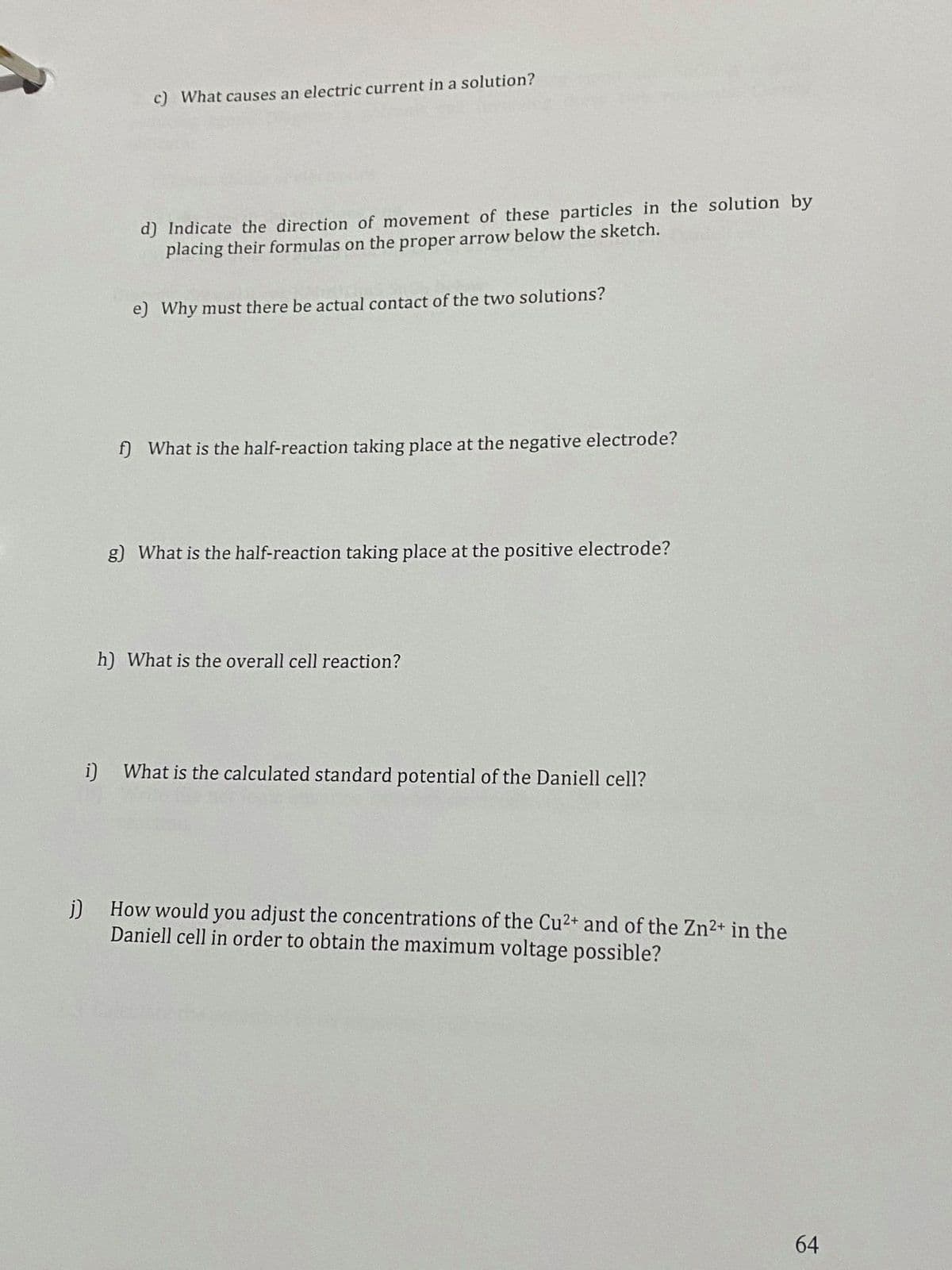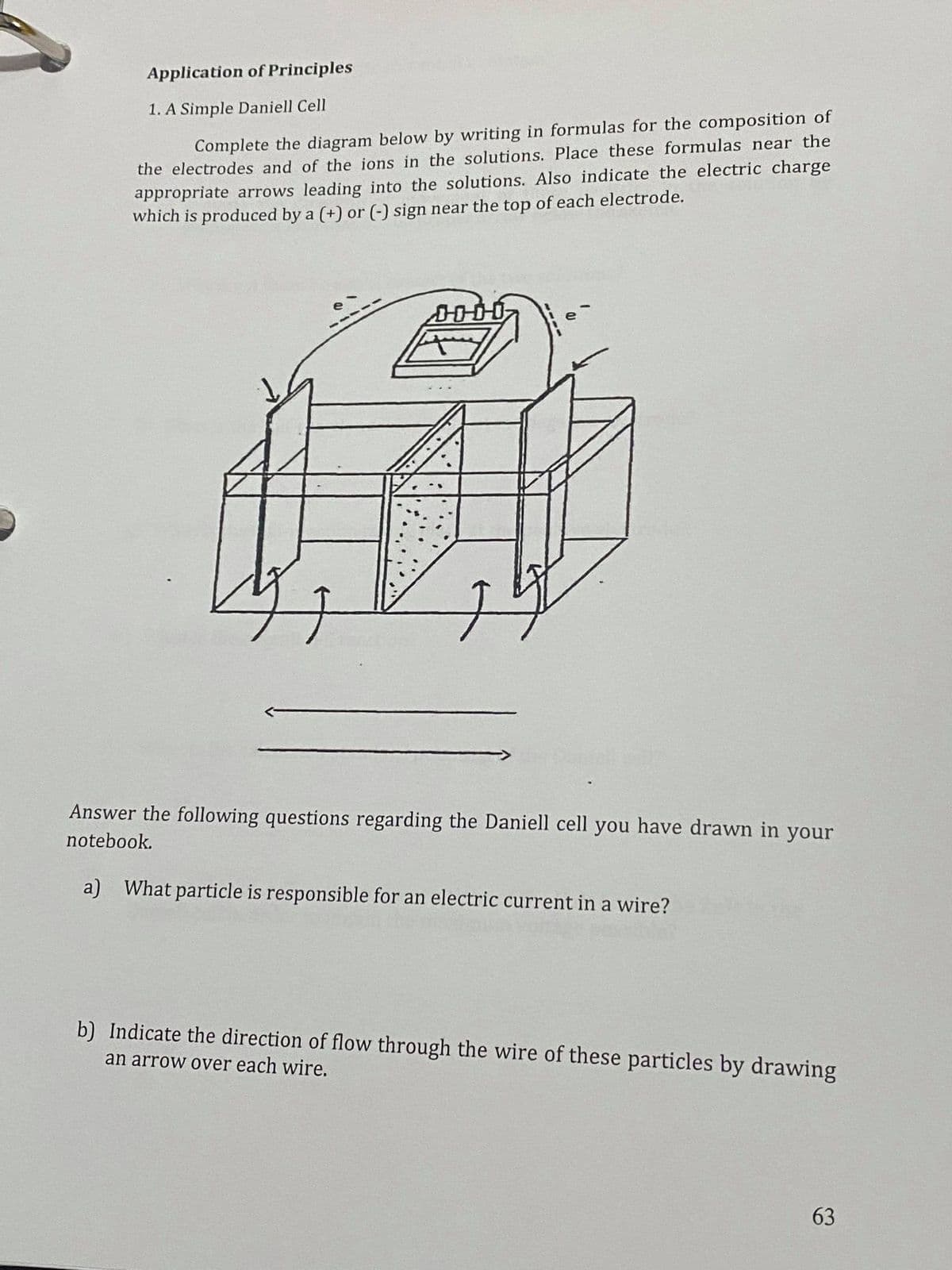Answer the following questions regarding the Daniell cell you have drawn in your notebook. a) What particle is responsible for an electric current in a wire? b) Indicate the direction of flow through the wire of these particles by drawing an arrow over each wire.
Answer the following questions regarding the Daniell cell you have drawn in your notebook. a) What particle is responsible for an electric current in a wire? b) Indicate the direction of flow through the wire of these particles by drawing an arrow over each wire.
Principles of Modern Chemistry
8th Edition
ISBN:9781305079113
Author:David W. Oxtoby, H. Pat Gillis, Laurie J. Butler
Publisher:David W. Oxtoby, H. Pat Gillis, Laurie J. Butler
Chapter17: Electrochemistry
Section: Chapter Questions
Problem 9P
Related questions
Question
can I get help with this, please?

Transcribed Image Text:c) What causes an electric current in a solution?
d) Indicate the direction of movement of these particles in the solution by
placing their formulas on the proper arrow below the sketch.
e) Why must there be actual contact of the two solutions?
f) What is the half-reaction taking place at the negative electrode?
g) What is the half-reaction taking place at the positive electrode?
h) What is the overall cell reaction?
i) What is the calculated standard potential of the Daniell cell?
j)
How would you adjust the concentrations of the Cu2+ and of the Zn2+ in the
Daniell cell in order to obtain the maximum voltage possible?
64

Transcribed Image Text:Application of Principles
1. A Simple Daniell Cell
Complete the diagram below by writing in formulas for the composition of
the electrodes and of the ions in the solutions. Place these formulas near the
appropriate arrows leading into the solutions. Also indicate the electric charge
which is produced by a (+) or (-) sign near the top of each electrode.
so00
Answer the following questions regarding the Daniell cell you have drawn in your
notebook.
a) What particle is responsible for an electric current in a wire?
b) Indicate the direction of flow through the wire of these particles by drawing
an arrow over each wire.
63
Expert Solution
This question has been solved!
Explore an expertly crafted, step-by-step solution for a thorough understanding of key concepts.
This is a popular solution!
Trending now
This is a popular solution!
Step by step
Solved in 3 steps with 2 images

Knowledge Booster
Learn more about
Need a deep-dive on the concept behind this application? Look no further. Learn more about this topic, chemistry and related others by exploring similar questions and additional content below.Recommended textbooks for you

Principles of Modern Chemistry
Chemistry
ISBN:
9781305079113
Author:
David W. Oxtoby, H. Pat Gillis, Laurie J. Butler
Publisher:
Cengage Learning

Chemistry: Principles and Practice
Chemistry
ISBN:
9780534420123
Author:
Daniel L. Reger, Scott R. Goode, David W. Ball, Edward Mercer
Publisher:
Cengage Learning


Principles of Modern Chemistry
Chemistry
ISBN:
9781305079113
Author:
David W. Oxtoby, H. Pat Gillis, Laurie J. Butler
Publisher:
Cengage Learning

Chemistry: Principles and Practice
Chemistry
ISBN:
9780534420123
Author:
Daniel L. Reger, Scott R. Goode, David W. Ball, Edward Mercer
Publisher:
Cengage Learning


Physical Chemistry
Chemistry
ISBN:
9781133958437
Author:
Ball, David W. (david Warren), BAER, Tomas
Publisher:
Wadsworth Cengage Learning,

Chemistry: Matter and Change
Chemistry
ISBN:
9780078746376
Author:
Dinah Zike, Laurel Dingrando, Nicholas Hainen, Cheryl Wistrom
Publisher:
Glencoe/McGraw-Hill School Pub Co

Chemistry: Principles and Reactions
Chemistry
ISBN:
9781305079373
Author:
William L. Masterton, Cecile N. Hurley
Publisher:
Cengage Learning